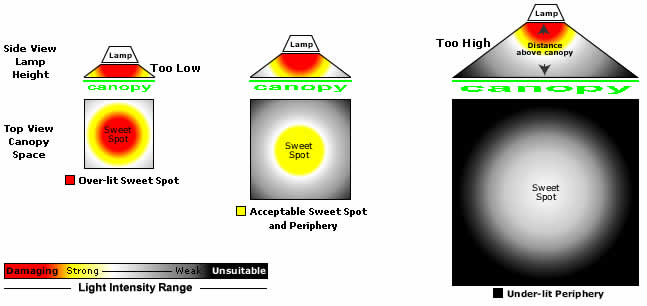
Lighting's impact on the value of indoor cannabis
yields is more than significant. It's not only the primary driving force behind the weight of our yields, but also the density
of the yield per square foot that gives shape to the weight. Light is a broad topic to be sure, and with many of
its challenges being double-edged it's not surprising to find light and space resources bound to one another by
their mere coexistence. With any given lamp, as a space grows larger its light intensity grows weaker. As shown in the
graphic to the left the relationship is direct and unbending. Although gardens can be found varying anywhere from one
extreme to the other, there are losses and gains challenging a grower from each side of that seesaw, both in
the weight of the harvest and in the weight of his satisfaction from its other traits. Yield alone is not the end-all
if one doesn't find a harvest appealing in other ways, nor is appeal the end-all if yield isn't satisfactory, somewhere
in the balance we each find our own personal brand of gratification.
cannabis
yields is more than significant. It's not only the primary driving force behind the weight of our yields, but also the density
of the yield per square foot that gives shape to the weight. Light is a broad topic to be sure, and with many of
its challenges being double-edged it's not surprising to find light and space resources bound to one another by
their mere coexistence. With any given lamp, as a space grows larger its light intensity grows weaker. As shown in the
graphic to the left the relationship is direct and unbending. Although gardens can be found varying anywhere from one
extreme to the other, there are losses and gains challenging a grower from each side of that seesaw, both in
the weight of the harvest and in the weight of his satisfaction from its other traits. Yield alone is not the end-all
if one doesn't find a harvest appealing in other ways, nor is appeal the end-all if yield isn't satisfactory, somewhere
in the balance we each find our own personal brand of gratification.
While trying to keep these challenges in perspective we'll examine such topics as available light, lumens, foot-candles, distance, sweet spot, footprint, total yield, density and yield per square foot to name a few. Once understood, it's hoped a grower will be better able to combine the focus he gives his space and light resources with density related esthetic values he expects from his harvest.
Available Light
Available light is the lumens available from your lamp to be distributed across your plant's canopy. It is not the light
striking your canopy, which is measured in foot-candles (fc)
at the canopy. Available light is a measure of lumens at the source, while foot-candles is a measure
of lumens at the target. Between these two points light is lost to empty space or objects that don't
reflect light, for the production minded indoor gardener that translates into lost growth and yield. Lamp-to-canopy
distance and your choice of reflectivity preferences will ultimately determine the light your plants receive.
Because cannabis is a high energy sun plant most indoor cannabis gardens have the available light very tightly focused, more so than gardens used for conventional indoor produce (vegetables, herbs, etc). As a result, indoor fc levels approaching that of the most intense sunlight can be reached or exceeded by growers, but can damage plants if heat from the lamp doesn't do more damage first. The most light intensity plants are likely to see in nature is around 10,000 fc, and for only a couple of hours during the day while the sun is directly overhead. For artificially lit plants, above 9,000 fc is considered shaky ground by many indoor growers, either due to the potential for damaged growth or for the more watchful eye needed to prevent it.
The YOR uses Available Lumens per Square Foot as a measure for the average available light distributed across a space. While this does address the space's average lighting, it does not reflect the closest safe-point when dealing with real lamp-to-canopy distances, nor does it reflect the furthest distance at which light can be used effectively.
Distance and the Sweet Spot
Every top-lit indoor garden using artificial HID lighting has a sweet spot located directly under the lamp, where
it's closest to the canopy. If not accounted for in your plans to distribute available light, fc in the sweet spot can
far exceed that of the sun, especially when lamp cooling technologies are used to reduce normal distances limited by
heat. Finding the limits of your coverage area implies a compromise between the minimum light levels at the outside edges
of your area (furthest from the lamp) and the maximum light level at the sweet spot (closest safe-point to the lamp).
The happy medium is not to overdose the sweet spot with too much light (or heat) and to distribute enough light to the
outside edges of your grow space for acceptable growth. The controlling factor for both of these limits is the
height of the lamp above the canopy. Reflective surfaces surrounding your garden will help reduce light losses
at the outside edges, but light at and below the sweet spot is controlled by distance between it and the lamp. The table
below gives an idea of the distances involved, fixtures used during the meter readings are common to indoor gardens.
|
Approximate fc in the sweet spot
(metered directly beneath the bulb) |
||
| Lamp | Distance | Foot-Candles |
| 1000 watt HPS | 1.50 foot (18 inches/45 cm) | 9,000 fc |
| 600 watt HPS | 1.00 foot (12 inches/30 cm) | 9,000 fc |
| 1.50 foot (18 inches/45 cm) | 5,600 fc | |
| 400 watt HPS | 0.75 foot (9 inches/23 cm) | 9,000 fc |
| 1.50 foot (18 inches/45 cm) | 4,000 fc | |
| 250 watt HPS | 0.58 foot (7 inches/18 cm) | 9,000 fc |
| 1.50 foot (18 inches/45 cm) | 2,800 fc | |
Highlighted items approximate the closest distance that particular lamp should be to the sweet spot to avoid over-lighting. (those interested in photosynthetic radiation can use this PPF PAR converter.) |
||
Footprint And Coverage Area
It's important to know what the usable footprint for your particular light fixture will be at those distances, fixtures
often vary from brand to brand. A good footprint test is to hold a lit fixture above the floor, at various distances,
while measuring the strongest light pattern shone on the floor. A safe compromise between over-lighting the sweet
spot and under-lighting the periphery is reached when the lamp is slightly above its closest safe-point
distance, while its strongest light pattern still covers the preferred garden dimensions.
The following graphics are of a square lamp fixture being used to create three footprints of varying sizes, they illustrate the interplay occurring between lamp height, canopy size, over-lighting and under-lighting.

One might wonder why the example on the right wouldn't be acceptable if the canopy space was made smaller to eliminate the under-lit periphery while the fixture was still left hanging high. The closer a lamp is to the top of the canopy the deeper it will penetrate into the sub-canopy, and the deeper the usable harvest (yield) will be. When a lamp is hung higher than it needs to be its effective downward range is reduced according to the Inverse Square Law for light intensity. As a result, the depth of the usable harvest will suffer, and because the canopy top will receive less light overall, it will produce less as well.
|
|
|
|
Next - |
|
|
|
|
|
|
|
|
|
|
|
|
|
|
|



